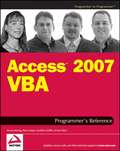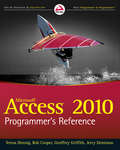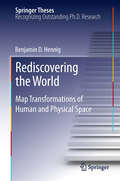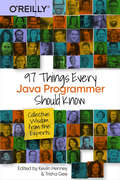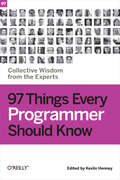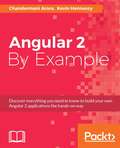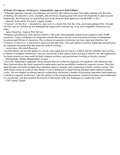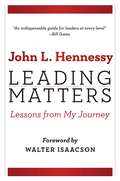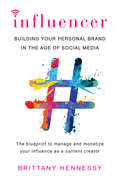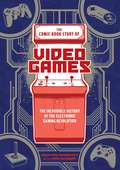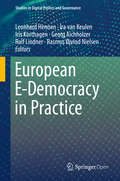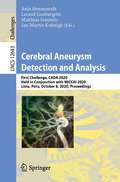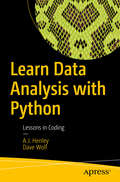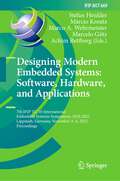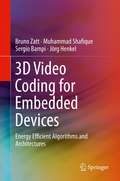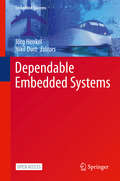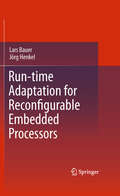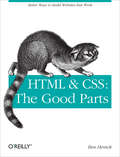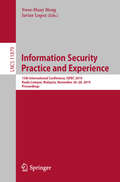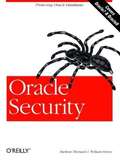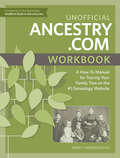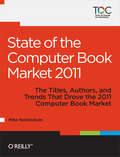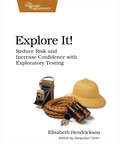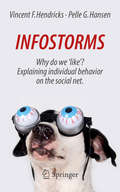- Table View
- List View
Access 2007 VBA Programmer's Reference
by Teresa Hennig Rob Cooper Geoffrey Griffith Armen SteinAccess 2007 VBA Programmer's Reference covers a wide spectrum of programming topics relevant to Access. Although it assumes the reader has some familiarity with VBA programming language, it begins with a brief introduction to VBA. And to help you leverage the tools that Access provides, a chapter highlights the new features in Microsoft Office Access 2007 -- including new wizards and GUI (graphical user interface) elements that previously required VBA code, as well as new VBA features. The book also discusses how to create and name variables, how to use Data Access Object (DAO) and ActiveX Data Object (ADO) to manipulate data both within Access and within other applications, proper error handling techniques, and advanced functions such as creating classes and using APIs. Key new objects such as using Macros and the Ribbon are explored, too, as are forms and reports, the two most powerful tools for working with and displaying data. Working with other applications is covered extensively both in a general nature and for working specifically with Microsoft Office applications, Windows SharePoint Services, and SQL Server. Of course, this book wouldn't be complete without discussing security issues and the Developer Extensions.
Access 2010 Programmer's Reference
by Teresa Hennig Rob Cooper Geoffrey L. Griffith Jerry DennisonA comprehensive guide to programming for Access 2010 and 2007 Millions of people use the Access database applications, and hundreds of thousands of developers work with Access daily. Access 2010 brings better integration with SQL Server and enhanced XML support; this Wrox guide shows developers how to take advantage of these and other improvements. With in-depth coverage of VBA, macros, and other programming methods for building Access applications, this book also provides real-world code examples to demonstrate each topic. Access 2010 Programmer's Referenceis a comprehensive guide to the best-of-breed techniques for programming Access applications. Coverage Includes: Introduction to Microsoft Access 2010 New Features Upgrading and Converting to Access 2010 Macros in Access 2010 Using the VBA Editor VBA Basics Using VBA in Access Creating Classes in VBA Extending VBA with APIs Working with the Windows Registry Using DAO to Access Data Using ADO to Access Data Using SQL with VBA Using VBA to Enhance Forms Enhancing Reports with VBA Customizing the Ribbon Customizing the Office Backstage Working with Office 2010 Working with SharePoint Working with . NET Building Client-Server Applications with Access The Access 2010 Templates Access Runtime Deployment Database Security Access 2010 Security Features
Rediscovering the World
by Benjamin Hennig'We need new maps' is the central claim made in this book. In a world increasingly influenced by human action and interaction, we still rely heavily on mapping techniques that were invented to discover unknown places and explore our physical environment. Although the traditional concept of a map is currently being revived in digital environments, the underlying mapping approaches are not capable of making the complexity of human-environment relationships fully comprehensible. Starting from how people can be put on the map in new ways, this book outlines the development of a novel technique that stretches a map according to quantitative data, such as population. The new maps are called gridded cartograms as the method is based on a grid onto which a density-equalising cartogram technique is applied. The underlying grid ensures the preservation of an accurate geographic reference to the real world. It allows the gridded cartograms to be used as basemaps onto which other information can be mapped. This applies to any geographic information from the human and physical environment. As demonstrated through the examples presented in this book, the new maps are not limited to showing population as a defining element for the transformation, but can show any quantitative geospatial data, such as wealth, rainfall, or even the environmental conditions of the oceans. The new maps also work at various scales, from a global perspective down to the scale of urban environments. The gridded cartogram technique is proposed as a new global and local map projection that is a viable and versatile alternative to other conventional map projections. The maps based on this technique open up a wide range of potential new applications to rediscover the diverse geographies of the world. They have the potential to allow us to gain new perspectives through detailed cartographic depictions.
97 Things Every Java Programmer Should Know: Collective Wisdom from the Experts
by Kevlin Henney Trisha GeeIf you want to push your Java skills to the next level, this book provides expert advice from Java leaders and practitioners. You’ll be encouraged to look at problems in new ways, take broader responsibility for your work, stretch yourself by learning new techniques, and become as good at the entire craft of development as you possibly can. <P><P>Edited by Kevlin Henney and Trisha Gee, 97 Things Every Java Programmer Should Know reflects lifetimes of experience writing Java software and living with the process of software development. Great programmers share their collected wisdom to help you rethink Java practices, whether working with legacy code or incorporating changes since Java 8. <P><P>A few of the 97 things you should know: <P><P>"Behavior Is Easy, State Is Hard"—Edson Yanaga <P><P>“Learn Java Idioms and Cache in Your Brain”—Jeanne Boyarsky <P><P>“Java Programming from a JVM Performance Perspective”—Monica Beckwith <P><P>"Garbage Collection Is Your Friend"—Holly K Cummins <P><P>“Java's Unspeakable Types”—Ben Evans <P><P>"The Rebirth of Java"—Sander Mak <P><P>“Do You Know What Time It Is?”—Christin Gorman
97 Things Every Programmer Should Know: Collective Wisdom from the Experts
by Kevlin HenneyTap into the wisdom of experts to learn what every programmer should know, no matter what language you use. With the 97 short and extremely useful tips for programmers in this book, you'll expand your skills by adopting new approaches to old problems, learning appropriate best practices, and honing your craft through sound advice. With contributions from some of the most experienced and respected practitioners in the industry--including Michael Feathers, Pete Goodliffe, Diomidis Spinellis, Cay Horstmann, Verity Stob, and many more--this book contains practical knowledge and principles that you can apply to all kinds of projects. A few of the 97 things you should know: "Code in the Language of the Domain" by Dan North "Write Tests for People" by Gerard Meszaros "Convenience Is Not an -ility" by Gregor Hohpe "Know Your IDE" by Heinz Kabutz "A Message to the Future" by Linda Rising "The Boy Scout Rule" by Robert C. Martin (Uncle Bob) "Beware the Share" by Udi Dahan
Angular 2 By Example
by Kevin Hennessy Chandermani AroraDiscover everything you need to know to build your own Angular 2 applications the hands-on way About This Book * Master the Angular way to structure, build, deploy, and test your code * Understand Angular 2's new component-based architecture * Build a game and workout runner apps on the Angular platform Who This Book Is For This book is for JavaScript developers who are new to Angular 2, or are familiar with the basics but want to take things a step further. If you are motivated to learn by doing things actively, this book is for you. What You Will Learn * Design, develop, deploy, and test the apps you build * Work your way through every aspect of app development using Angular2 * Understand the inner workings of Angular's view templating and data-binding capabilities * Work on HTML forms and learn the Angular way to bind, validate, and format data * Create component, structural, and attribute directives to extend standard HTML behavior * Integrate with the server backend and find out about data retrieval and persistence using Angular * Gain practical insight into the challenges of building apps using Angular as well as their solutions In Detail Angular 2 will help you build faster, more efficient, and more flexible cross-platform applications. Angular 2 is known for taking the pain out of JavaScript development, and enabling more organized, readable, and testable code. This book builds three apps with varying degrees of complexity. It starts with a simple 'Guess the Number' game, which serves as a platform to launch you into the world of Angular. Next, you will learn to construct a popular '7-Minute Workout' app, covering the building blocks of Angular. The final app, 'Personal Trainer' morphs the existing '7-Minute Workout' into a full-fledged personal workout builder and runner, covering advanced directive building, which is the most fundamental and powerful feature of Angular. In addition to this, you will learn about testability and the framework constructs Angular provides to effectively test your app. The book concludes by providing you with practical advice and useful tips that will come in handy as you build more and more apps with Angular. Style and approach This project-based book will get you building fun projects to see how Angular works in the wild. The book focuses more on doing things rather than just reading the theory. The chapters are structured to introduce the concept, then implement it, and finally explain why it worked.
Computer Architecture: A Quantitative Approach (The Morgan Kaufmann Series in Computer Architecture and Design)
by John L. Hennessy David A. PattersonComputer Architecture: A Quantitative Approach, Sixth Edition has been considered essential reading by instructors, students and practitioners of computer design for over 20 years. The sixth edition of this classic textbook from Hennessy and Patterson, winners of the 2017 ACM A.M. Turing Award recognizing contributions of lasting and major technical importance to the computing field, is fully revised with the latest developments in processor and system architecture. <p><p>The text now features examples from the RISC V (RISC Five) instruction set architecture, a modern RISC instruction set developed and designed to be a free and openly adoptable standard. It also includes a new chapter on domain specific architectures and an updated chapter on warehouse scale computing that features the first public information on Google's newest WSC.
Leading Matters: Lessons from My Journey
by John L. Hennessy Walter IsaacsonIn Leading Matters, current Chairman of Alphabet (Google's parent company), former President of Stanford University, and "Godfather of Silicon Valley," John L. Hennessy shares the core elements of leadership that helped him become a successful tech entrepreneur, esteemed academic, and venerated administrator. Hennessy's approach to leadership is laser-focused on the journey rather than the destination. Each chapter in Leading Matters looks at valuable elements that have shaped Hennessy's career in practice and philosophy. He discusses the pivotal role that humility, authenticity and trust, service, empathy, courage, collaboration, innovation, intellectual curiosity, storytelling, and legacy have all played in his prolific, interdisciplinary career. Hennessy takes these elements and applies them to instructive stories, such as his encounters with other Silicon Valley leaders including Jim Clark, founder of Netscape; Condoleezza Rice, former U.S. Secretary of State and Stanford provost; John Arrillaga, one of the most successful Silicon Valley commercial real estate developers; and Phil Knight, founder of Nike and philanthropist with whom Hennessy cofounded Knight-Hennessy Scholars at Stanford University. Across government, education, commerce, and non-profits, the need for effective leadership could not be more pressing. This book is essential reading for those tasked with leading any complex enterprise in the academic, not-for-profit, or for-profit sector.
Influencer: Building Your Personal Brand in the Age of Social Media
by Brittany Hennessy“I highly advise anyone who has an interest in life online to get this book, sit down, and take notes because you're going to want to hear what Brittany has to say.” –Iskra Lawrence, Aerie Model and Instagram star (@iskra) If you’ve ever scrolled through your Instagram feed and thought, I wear clothes, eat avocado toast and like sunsets, why can’t someone pay me to live my best life? this book is for you . . . Every one of your favorite influencers started with zero followers and had to make a lot of mistakes to get where they are today—earning more money each year than their parents made in the last decade. But to become a top creator, you need to understand the strategies behind the Insta-ready lifestyle . . . As nightlife blogger, then social media strategist, and now Senior Director of Influencer Strategy and Talent Partnerships at Hearst Magazines Digital Media, Brittany Hennessy has seen the role of influencers evolve and expand into something that few could have imagined when social media first emerged. She has unrivaled insight into where the branded content industry was, where it is, and where it's going. In this book she'll reveal how to: *Build an audience and keep them engaged *Package your brand and pitch your favorite companies *Monetize your influence and figure out how much to charge Plus tips on: *Landing an agent *Getting on the radar of your favorite sites *Praising a brand without alienating their competitors Whether you’re just starting out or you're ready for bigger campaigns, Hennessy guides you through core influencer principles. From creating content worth double tapping and using hashtags to get discovered, to understanding FTC rules and delivering metrics, she’ll show you how to elevate your profile, embrace your edge, and make money—all while doing what you love.
The Comic Book Story of Video Games: The Incredible History of the Electronic Gaming Revolution (Comic Book Story of)
by Jonathan HennesseyA complete, illustrated history of video games--highlighting the machines, games, and people who have made gaming a worldwide, billion-dollar industry/artform--told in a graphic novel format. Author Jonathan Hennessey and illustrator Jack McGowan present the first full-color, chronological origin story for this hugely successful, omnipresent artform and business. Hennessey provides readers with everything they need to know about video games--from their early beginnings during World War II to the emergence of arcade games in the 1970s to the rise of Nintendo to today's app-based games like Angry Birds and Pokemon Go. Hennessey and McGowan also analyze the evolution of gaming as an artform and its impact on society. Each chapter features spotlights on major players in the development of games and gaming that contains everything that gamers and non-gamers alike need to understand and appreciate this incredible phenomenon.
European E-Democracy in Practice (Studies in Digital Politics and Governance)
by Leonhard Hennen Ira Van Keulen Iris Korthagen Georg Aichholzer Ralf Lindner Rasmus Øjvind NielsenThis open access book explores how digital tools and social media technologies can contribute to better participation and involvement of EU citizens in European politics. By analyzing selected representative e-participation projects at the local, national and European governmental levels, it identifies the preconditions, best practices and shortcomings of e-participation practices in connection with EU decision-making procedures and institutions. The book features case studies on parliamentary monitoring, e-voting practices, and e-publics, and offers recommendations for improving the integration of e-democracy in European politics and governance. Accordingly, it will appeal to scholars as well as practitioners interested in identifying suitable e-participation tools for European institutions and thus helps to reduce the EU’s current democratic deficit. This book is a continuation of the book “Electronic Democracy in Europe” published by Springer.
Cerebral Aneurysm Detection and Analysis: First Challenge, CADA 2020, Held in Conjunction with MICCAI 2020, Lima, Peru, October 8, 2020, Proceedings (Lecture Notes in Computer Science #12643)
by Anja Hennemuth Leonid Goubergrits Matthias Ivantsits Jan-Martin KuhnigkThis book constitutes the First Cerebral Aneurysm Detection Challenge, CADA 2020, which was held in conjunction with the 23rd International Conference on Medical Image Computing and Computer-Assisted Intervention, MICCAI 2020, in October 2020. The conference was planned to take place in Lima, Peru, and took place virtually due to the COVID-19 pandemic. The 9 regular papers presented in this volume, together with an overview and one introduction paper, were carefully reviewed and selected for inclusion in the book. The papers were organized in topical sections as follows: cerebral aneurysm detection; cerebral aneurysm segmentation; and cerebral aneurysm rupture risk estimation.
Learn Data Analysis with Python: Lessons In Coding
by A. J. Henley Dave WolfGet started using Python in data analysis with this compact practical guide. This book includes three exercises and a case study on getting data in and out of Python code in the right format. Learn Data Analysis with Python also helps you discover meaning in the data using analysis and shows you how to visualize it. Each lesson is, as much as possible, self-contained to allow you to dip in and out of the examples as your needs dictate. If you are already using Python for data analysis, you will find a number of things that you wish you knew how to do in Python. You can then take these techniques and apply them directly to your own projects.If you aren’t using Python for data analysis, this book takes you through the basics at the beginning to give you a solid foundation in the topic. As you work your way through the book you will have a better of idea of how to use Python for data analysis when you are finished.What You Will LearnGet data into and out of Python codePrepare the data and its formatFind the meaning of the dataVisualize the data using iPythonWho This Book Is For Those who want to learn data analysis using Python. Some experience with Python is recommended but not required, as is some prior experience with data analysis or data science.
Designing Modern Embedded Systems: 7th IFIP TC 10 International Embedded Systems Symposium, IESS 2022, Lippstadt, Germany, November 3–4, 2022, Proceedings (IFIP Advances in Information and Communication Technology #669)
by Stefan Henkler Márcio Kreutz Marco A. Wehrmeister Marcelo Götz Achim RettbergThis book constitutes the refereed proceedings of the 7th IFIP TC 10 International Embedded Systems Symposium, IESS 2022, held in Lippstadt, Germany, during November 3-4, 2022. The 10 full revised papers and 2 short papers presented were carefully reviewed and selected from 13 submissions. The presented research and technical works cover system-level design methods, algorithms, verification and validation techniques, estimation of system properties and characteristics, performance analysis, and real-time systems design. Also, the book presents industrial and real-world application case studies that discuss the challenges and realizations of modern embedded systems, especially when it comes to including artificial intelligence algorithms and techniques in embedded systems.
3D Video Coding for Embedded Devices: Energy Efficient Algorithms and Architectures
by Jörg Henkel Muhammad Shafique Sergio Bampi Bruno ZattThis book shows readers how to develop energy-efficient algorithms and hardware architectures to enable high-definition 3D video coding on resource-constrained embedded devices. Users of the Multiview Video Coding (MVC) standard face the challenge of exploiting its 3D video-specific coding tools for increasing compression efficiency at the cost of increasing computational complexity and, consequently, the energy consumption. This book enables readers to reduce the multiview video coding energy consumption through jointly considering the algorithmic and architectural levels. Coverage includes an introduction to 3D videos and an extensive discussion of the current state-of-the-art of 3D video coding, as well as energy-efficient algorithms for 3D video coding and energy-efficient hardware architecture for 3D video coding.
Dependable Embedded Systems (Embedded Systems)
by Jörg Henkel Nikil DuttThis Open Access book introduces readers to many new techniques for enhancing and optimizing reliability in embedded systems, which have emerged particularly within the last five years. This book introduces the most prominent reliability concerns from today’s points of view and roughly recapitulates the progress in the community so far. Unlike other books that focus on a single abstraction level such circuit level or system level alone, the focus of this book is to deal with the different reliability challenges across different levels starting from the physical level all the way to the system level (cross-layer approaches). The book aims at demonstrating how new hardware/software co-design solution can be proposed to ef-fectively mitigate reliability degradation such as transistor aging, processor variation, temperature effects, soft errors, etc.Provides readers with latest insights into novel, cross-layer methods and models with respect to dependability of embedded systems;Describes cross-layer approaches that can leverage reliability through techniques that are pro-actively designed with respect to techniques at other layers;Explains run-time adaptation and concepts/means of self-organization, in order to achieve error resiliency in complex, future many core systems.
Run-time Adaptation for Reconfigurable Embedded Processors
by Jörg Henkel Lars BauerEmbedded processors are the heart of embedded systems. Reconfigurable embedded processors comprise an extended instruction set that is implemented using a reconfigurable fabric (similar to a field-programmable gate array, FPGA). This book presents novel concepts, strategies, and implementations to increase the run-time adaptivity of reconfigurable embedded processors. Concepts and techniques are presented in an accessible, yet rigorous context. A complex, realistic H.264 video encoder application with a high demand for adaptivity is presented and used as an example for motivation throughout the book. A novel, run-time system is demonstrated to exploit the potential for adaptivity and particular approaches/algorithms are presented to implement it.
HTML & CSS: Better Ways to Build Websites That Work (Animal Guide)
by Ben HenickHTML and CSS are the workhorses of web design, and using them together to build consistent, reliable web pages requires both skill and knowledge. The task is more difficult if you're relying on outdated, confusing, and unnecessary HTML hacks and workarounds. Author Ben Henick shows you how to avoid those traps by going beyond the standard tips, tricks, and techniques to connect the underlying theory and design of HTML and CSS to your everyday work habits. With this practical book, you'll learn how to work with these tools far more effectively than is standard practice for most web developers. Whether you handcraft individual pages or build templates, HTML & CSS: The Good Parts will help you get the most out of these tools in all aspects of web page design-from layout to typography and to color. Structure HTML markup to maximize the power of CSS Implement complex multi-column layouts from scratch Improve site production values with advanced CSS techniques Support formal usability and accessibility requirements with tools built into HTML and CSS Avoid the most annoying browser and platform limitations
Verification, Model Checking, and Abstract Interpretation: 22nd International Conference, VMCAI 2021, Copenhagen, Denmark, January 17–19, 2021, Proceedings (Lecture Notes in Computer Science #12597)
by Fritz Henglein Sharon Shoham Yakir VizelThis book constitutes the proceedings of the 22nd International Conference on Verification, Model Checking, and Abstract Interpretation, VMCAI 2021, which was held virtually during January 17-19, 2021. The conference was planned to take place in Copenhagen, Denmark, but changed to an online event due to the COVID-19 pandemic. The 23 papers presented in this volume were carefully reviewed from 48 submissions. VMCAI provides a forum for researchers working on verification, model checking, and abstract interpretation and facilitates interaction, cross-fertilization, and advancement of hybrid methods that combine these and related areas. The papers presented in this volume were organized in the following topical sections: hyperproperties and infinite-state systems; concurrent and distributed systems; checking; synthesis and repair; applications; and decision procedures.
Information Security Practice and Experience: 15th International Conference, ISPEC 2019, Kuala Lumpur, Malaysia, November 26–28, 2019, Proceedings (Lecture Notes in Computer Science #11879)
by Swee-Huay Heng Javier LopezThis book constitutes the refereed proceedings of the 15th International Conference on Information Security Practice and Experience, ISPEC 2019, held in Kuala Lumpur, Malaysia, in November 2019. The 21 full and 7 short papers presented in this volume were carefully reviewed and selected from 68 submissions. They were organized into the following topical sections: Cryptography I, System and Network Security, Security Protocol and Tool, Access Control and Authentication, Cryptography II, Data and User Privacy, Short Paper I, and Short Paper II.
Oracle Security
by William Heney Marlene TheriaultThis book covers the field of Oracle security from simple to complex. It describes basic RDBMS security features (e.g., passwords, profiles, roles, privileges, synonyms) and includes many practical strategies for securing an Oracle system, developing auditing and backup plans, and using the Oracle Enterprise Manager and Oracle Security Server. Also touches on advanced security features, such as encryption, Trusted Oracle, and Internet and Web protection.
Unofficial Ancestry.com Workbook: A How-To Manual for Tracing Your Family Tree on the #1 Genealogy Website
by Nancy HendricksonA How-To Manual for Tracing Your Family Tree on the #1 Genealogy Website
State of the Computer Book Market 2011
by Mike HendricksonThis annual report examines the key trends and developments -- most notably, the demise of Borders -- that shaped the 2011 computer book market.
Explore It!: Reduce Risk and Increase Confidence with Exploratory Testing
by Elisabeth HendricksonUncover surprises, risks, and potentially serious bugs with exploratory testing. Rather than designing all tests in advance, explorers design and execute small, rapid experiments, using what they learned from the last little experiment to inform the next. Learn essential skills of a master explorer, including how to analyze software to discover key points of vulnerability, how to design experiments on the fly, how to hone your observation skills, and how to focus your efforts.Software is full of surprises. No matter how careful or skilled you are, when you create software it can behave differently than you intended. Exploratory testing mitigates those risks. Part 1 introduces the core, essential skills of a master explorer. You'll learn to craft charters to guide your exploration, to observe what's really happening (hint: it's harder than it sounds), to identify interesting variations, and to determine what expected behavior should be when exercising software in unexpected ways. Part 2 builds on that foundation. You'll learn how to explore by varying interactions, sequences, data, timing, and configurations. Along the way you'll see how to incorporate analysis techniques like state modeling, data modeling, and defining context diagrams into your explorer's arsenal. Part 3 brings the techniques back into the context of a software project. You'll apply the skills and techniques in a variety of contexts and integrate exploration into the development cycle from the very beginning.You can apply the techniques in this book to any kind of software. Whether you work on embedded systems, Web applications, desktop applications, APIs, or something else, you'll find this book contains a wealth of concrete and practical advice about exploring your software to discover its capabilities, limitations, and risks.
Infostorms: Why do we 'like'? Explaining individual behavior on the social net, 2nd Edition
by Vincent F. Hendricks Pelle G. HansenWith points of departure in philosophy, logic, social psychology, economics, and choice and game theory, Infostorms shows how information may be used to improve the quality of personal decision and group thinking but also warns against the informational pitfalls which modern information technology may amplify: From science to reality culture and what it really is, that makes you buy a book like this.<P><P> The information society is upon us. New technologies have given us back pocket libraries, online discussion forums, blogs, crowdbased opinion aggregators, social media and breaking news wherever, whenever. But are we more enlightened and rational because of it? <P> Infostorms provides the nuts and bolts of how irrational group behaviour may get amplified by social media and information technology. If we could be collectively dense before, now we can do it at light speed and with potentially global reach. That’s how things go viral, that is how cyberbullying, rude comments online, opinion bubbles, status bubbles, political polarisation and a host of other everyday unpleasantries start. Infostorms will give the story of the mechanics of these phenomena. This will help you to avoid them if you want or learn to start them if you must. It will allow you to stay sane in an insane world of information.
